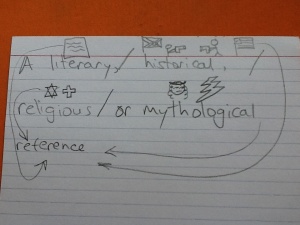Learning Then Anchoring Curricular Definitions
Recently, a tutor, and the mother of an older student asked for help with complex definitions, and how to help students memorize them, really understand them, and retrieve the words on tests. This is a post from 2013 that I thought might be worth posting again.
This student had all but given up on memorizing vocabulary in science, social studies and literature because she could not handle all of the dense language that seemed meaningless. Here is how we broke down (discussing each phrase separately) the definition for “allegory – a narrative in which the characters, behavior and setting demonstrate multiple levels of meaning and significance.” When she read the definition to me, all of the words were rushed together, she was not parsing them out for meaning making short-term memorization difficult.
In order to help her anchor the meaning to the actual vocabulary word (she had 20 multisyllabic words to remember), the student realized there were two Ls in the word, so we wrote Level 1 and Level 2. The gestalt of the definition is that what you see is not what you get, there is deeper meaning. She said, “Like layers of an onion” so we turned the “o” into an onion. “Story” rhymes with “gory” so we wrote that on the card as well. Here is the front of the index card:
Here is another card we did for allusion:
Notice that the actual letters of the word contain the very concepts that are embedded in the definition so the student had visual anchors to recall the word. The A became a Star of David (religious), the LL became a piece of literature, the U became a boat in Boston Harbor (historical) and the I became Zeus’s lightening bolt (mythological).
After studying her vocabulary terms this way, she happily announced that she had gotten a good grade on her test!





